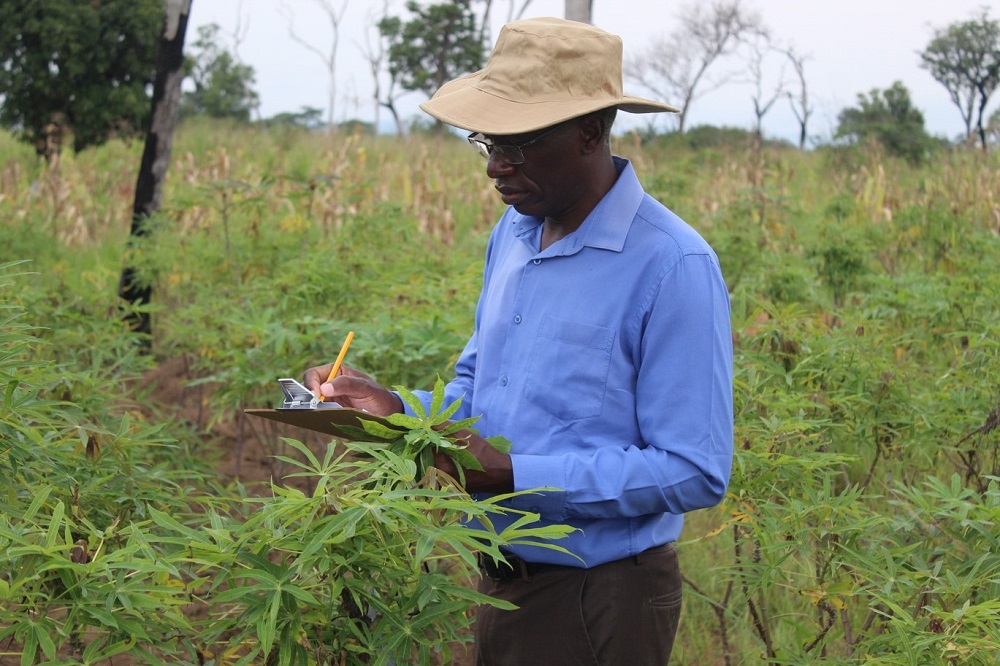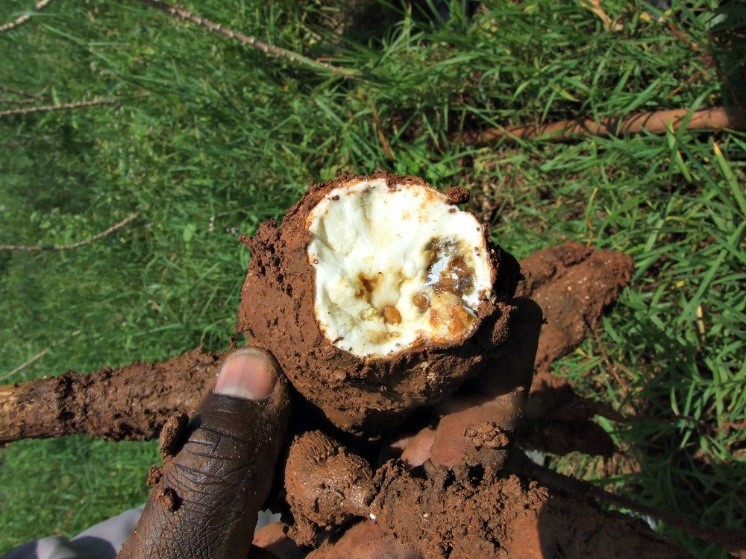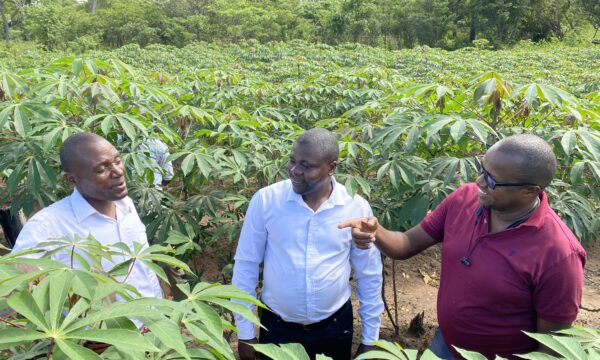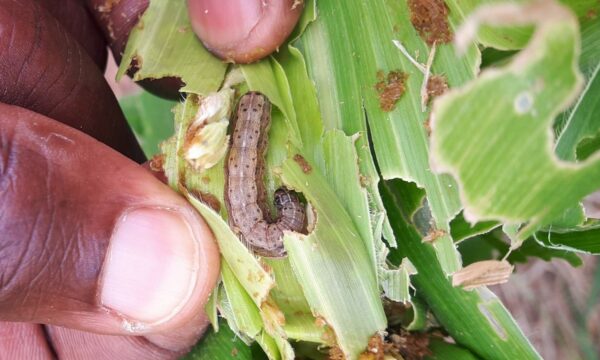
A new evidence note published by CABI is highlighting the impacts and management strategies for Cassava Brown Streak Disease (CBSD) in Zambia, which threatens cassava yields – a staple crop for nearly six million Zambians.
Background
Cassava is an important food security crop with over 70% of its global production accounted for by sub-Saharan. In Zambia, cassava is the second most important crop after maize, which is increasingly gaining importance as a promising drought insurance crop suited for climate change mitigation.
Over the past decade, developments in the cassava sub-sector have instigated a new interest in large-scale cassava production by local companies.
Zambia breweries, Zhongkai international, Itabwa Investments and Sun Bird International collectively require over 50,000 tonnes of daily cassava feedstock for various industrial uses including brewing, mining, confectionary and biofuel production.
Zambia’s cassava sub-sector is poised to enhance job creation, increase household income, food security and export markets.
Unfortunately, the invasive cassava brown streak disease (CBSD), a fairly new viral disease in Zambia threatens the development of Zambia’s cassava sub-sector.
CABI’s new evidence note ‘Cassava Brown Streak Disease (CBSD) An Evidence Note on Impacts and Management Strategies for Zambia’ reveals that CBSD can cause yield losses of up to 100% in susceptible varieties and has become the leading constraint to cassava production in sub-Saharan Africa.
CBSD originated from the coastal region of East Africa close to the mid-20th century and has spread to central and southern Africa. The exact origin of CBSD in Zambia is not certain, but being a landlocked country with eight neighbouring countries, there are speculations of the disease having originated from some of her neighbours.
Five of Zambia’s neighbours have confirmed CBSD presence for over three years, although Malawi, Mozambique and Congo struggled with it for more than a decade.
CBSD was first diagnosed in cassava samples collected from the North-western province during routine pest surveillance Subsequently, CBSD prevalence was confirmed in Kaputa and Chienge districts at 32.3% incidence, and has since spread to other districts. Estimated losses due to CBSD in Zambia are around 55% of total cassava production, equivalent to monetary losses of over US $500,000.
Status of CBSD in Zambia
CBSD is spreading across Zambia’s northerly districts since its first detection in 2018 by the Zambia Agricultural Research Institute (ZARI). Farmers in the affected regions report substantial losses in cassava production due to severe hard rots in harvested roots and reduction in root quality caused by pitting and constrictions.
A 2021 survey conducted by CABI to assess the prevalence and impact of CBSD in Zambia’s traditional cassava growing regions revealed widespread root damage symptoms reported by 51% of respondent farmers.
Typical leaf and stem symptoms were also reported by 42 and 36%, respectively of the interviewed 516 farmers, although they were unable to identify CBSD by name. Despite 67% of the farmers indicating regular field monitoring for abnormal changes or pest presence, limited knowledge of CBSD impedes effective control or management of the disease in Zambia.

Dr Chapwa Kasoma, one of the authors of the evidence note on CBSD, said, “Most farmers admitted that their reactions to CBSD damage in their fields, which included plucking of infected leaves, were merely impulsive and unscientific. Across all the three districts surveyed, farmers appealed to be sensitized on effective and science-based methods to manage CBSD.”
In response to the need for awareness of CBSD, CABI, has launched a communication campaign targeting various stakeholders within the cassava value chain.
Campaign activities so far conducted in partnership with ZARI and the Department of Agriculture have included, sensitization meetings, radio programs, posters, videos and plant health rallies. These efforts have largely targeted cassava farmers and extensionists, who were identified as the strongest stakeholder link to immediate action on CBSD mitigation.
In a news story published by the Times of Zambia, Dr Patrick Chikoti, Chief Agricultural Research Officer at ZARI said the Government considered CBSD as a disease of economic importance. “With the climate changes which have affected a lot of cereal crops, cassava is a crop to fall back on because it is drought resistant and can withstand floods. Hence the outbreak of CSBD should be handled with the seriousness it deserves to keep the industry thriving,” he said.
The way forward
As with most invasive plant diseases, the most sustainable solution is the use of resistant crop varieties. ZARI and the International Institute for Tropical Agriculture (IITA) embarked on the breeding of cassava for resistance to the CBSD as a long-term strategy.
In the short term, immediate action is required to curb the spread of CBSD, which has not yet been detected in most of Zambia’s 10 provinces. However, the ongoing promotion of large-scale cassava production by several organizations through farmer out grower schemes presents high chances for the rapid spread of CBSD to other provinces if precautionary measures are not taken.
Additional information
Main image: Dr Patrick Chikoti, Chief Agricultural Research Officer at ZARI inspecting a cassava field in Zambia (Credit: Patrick Chikoti).
Key immediate actions for targeted stakeholders
To prevent the spread of CBSD to new areas and mitigate its impacts in the affected areas, the movement, sharing and propagation of diseased cassava cuttings should be prevented. To achieve this, technical, financial and policy support from the government and donor agencies is critical and CABI’s evidence note highlights key immediate actions for targeted stakeholders.
Donor agencies in partnership with farming communities
• Expansion of the provision of disease-free cassava cuttings to enable easy access to planting material by local farmers.
Regulators and policy makers
• Institute stringent quarantine regulations to prevent the movement of CBSD infected cassava cuttings.
• Implement rigorous phytosanitary standards for multiplication and certification, distribution of cassava planting material.
Farmer advisers and advisory services
• Educate farmers on the role they play in exacerbating CBSD spread through the movement and sharing of diseased cuttings.
• Adequately train farmers contracted as cassava seed multipliers to minimise CBSD transmission through planting material.
Farmers
• Institute concerted community-level actions to implement appropriate sanitary and phytosanitary measures, including sourcing and maintenance of CBSD-free planting material, and subsequent selection of clean cuttings for propagating new fields of cassava.
Full evidence note
You can read the evidence note ‘Cassava Brown Streak Disease (CBSD) An Evidence Note on Impacts and Management Strategies for Zambia’ here.
Relevant blog
See also the blog ‘Campaign to tackle Cassava Brown Streak Disease in Zambia takes hold after workshop.’
Acknowledgements
This evidence note was prepared as part of the PlantwisePlus programme. PlantwisePlus is supported by contributions from the UK Foreign, Commonwealth and Development Office, the Swiss Agency for Development and Cooperation, the Netherlands Ministry of Foreign Affairs and the European Commission (DG INTPA).
We express sincere gratitude to our partners, ZARI and the DoA of the Ministry of Agriculture in Zambia, for supporting the implementation of this work. We owe special thanks to Mr Suwilanji Sichilima, Mr Henry Mgomba and Mr Jackson Mwenya for their supervision during the data collection process. We are grateful for the invaluable input from our CABI colleagues, Noah Anthony Phiri and Judith Chowa, who have immensely supported this work. We acknowledge the hard work and willingness of the entire data collection team and all the district agricultural extension staff from Chienge, Kabompo and Kaputa district offices in facilitating the study’s implementation. To the participant farmers, who provided key information that formed the bulk of this study, we are sincerely thankful for your time, willingness to participate and hospitality.
2 Comments
Leave a Reply
Related News & Blogs
Celebrating success: Zambian smallholders combat cassava brown streak disease
Cassava is a critical crop to Zambia’s economy and food security. According to a 2019 paper, cassava (Manihot esculenta) is one of the most important root staple crops in Zambia. An estimated 30% of Zambians – over four million people – consume cassava…
8 November 2024





Hello,
Think that rapid testing can help in screening. Agdia/Biofords has Immunostrip for rapid detection of Potyvirus group. https://www.agdia.com/testing-services/potyviridae-group-test
Although it can’t pin point CBSD from others, think rapid on site detection of Potyvirus group can be effective if positioned on critical points i. e planting material distribution points, extension services, etc.
Kind Regards,
Igor Konrad
Can I be part of the research team please